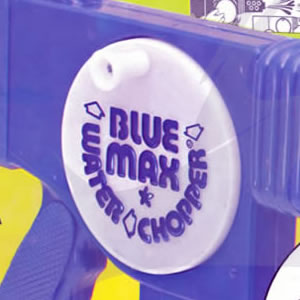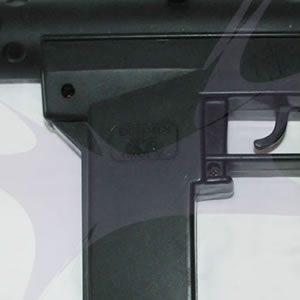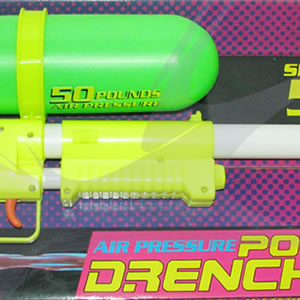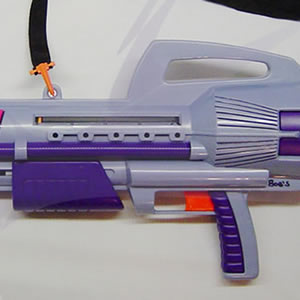
 Expectations for 2017 .:
Expectations for 2017 .:
Water weaponry has gone through a varied path along both its design as well as technological evolution. With the earliest known water blasters were made in the late 1890s (see Oldest Known Water Guns / Water Blasters), being styled after real weaponry, though the term "squirt gun" has been quoted as far back as 1861. The original water guns appeared to rely on some sort of squeeze/rubber bulb (akin to old-fashion perfume bottles) to provide the "pump" mechanism to generate streams. I am currently unclear when the first trigger-based water blasters were made. This would have had to be after it became simpler and cheaper to mass-produce the ball-bearing based check valves.
The 1970s Water Blasters .:
Trigger-pump water blasters were plentiful by the 1970s.  By the late-1970s, Larami released a crank-action water gun, the Blue Max Water Chopper, that appears to have used a peristaltic-type pump instead of a trigger-based pump, and was apparently able to produce continuous streams. Also released around a similar time was the Cosmic Liquidator, the first known air-pressure-based water blaster.
By the late-1970s, Larami released a crank-action water gun, the Blue Max Water Chopper, that appears to have used a peristaltic-type pump instead of a trigger-based pump, and was apparently able to produce continuous streams. Also released around a similar time was the Cosmic Liquidator, the first known air-pressure-based water blaster.  Being pressurized, the Cosmic Liquidator also could produce continuous streams and outperformed any trigger-based rivals, but its multi-part nature and potentially fragile tubing and connections resulted in poorer performance than what this pressurized technology was actually capable of. Unfortunately, likely due to sluggish sales, this form of technology was abandoned for over a decade.
Being pressurized, the Cosmic Liquidator also could produce continuous streams and outperformed any trigger-based rivals, but its multi-part nature and potentially fragile tubing and connections resulted in poorer performance than what this pressurized technology was actually capable of. Unfortunately, likely due to sluggish sales, this form of technology was abandoned for over a decade.
The 1980s Water Blasters .:
The early 1980s water blaster market was still primarily dominated by trigger-based "squirt guns", but in the mid-1980s, the first motor-driven water guns were released. Two companies, Larami and Entertech, released a number of motorized water blasters, the majority of which were all coloured and stylized after real weaponry.  Water blasters like the Larami Uzi and Entertech Waterhawk became exceedingly popular with children of all ages. The actual pump in these motorized water blasters was really not significantly different than the pump found in the trigger-based "squirt guns". However, instead of the user's energy being used to create the force, the trigger on a motorized water gun functions merely as a switch to activate a motor which then drives the pump's piston to create pressure (*Note: this is a good reminder that I forgot to complete the various motorized technology overview pages for iSoaker.com*) Some of the more recent motorized water blasters have used another type of pump, but that's another story. Therefore, motorized water blasters will continue to blast so long as the trigger is depressed (and there is enough water and battery power to keep the pump going). Of course, since the actual pumps were piston-based, these water blasters produced pulsating, not continuous streams. Nevertheless, compared to "squirt guns" and any other of the manually-activated water guns available, the performance and role-playing aspect of these realistically-styled water guns took over the market. Unfortunately, due to wide prevalence of these water blasters combined with their realistic sizing and styling, some were mistaken (or intentionally used to be mistsaken) for real weapons and some users ended up being shot and/or killed while brandishing these first-generation motorized water blasters. After a few reported deaths had appeared on the news, it became required for water blaster manufacturers to put a bright orange tip ("blaze orange tip") on all their toy water blasters to help others distinguish them from real weapons. Eventually, since some dishonest people would repaint/recolour the tips back to all-black, manufacturers ended up making the entire water blaster some bright, loud colour such as orange, yellow, or red, often with colourful striping as well to make it much more difficult to someone to mistaken these toys for real weapons.
Water blasters like the Larami Uzi and Entertech Waterhawk became exceedingly popular with children of all ages. The actual pump in these motorized water blasters was really not significantly different than the pump found in the trigger-based "squirt guns". However, instead of the user's energy being used to create the force, the trigger on a motorized water gun functions merely as a switch to activate a motor which then drives the pump's piston to create pressure (*Note: this is a good reminder that I forgot to complete the various motorized technology overview pages for iSoaker.com*) Some of the more recent motorized water blasters have used another type of pump, but that's another story. Therefore, motorized water blasters will continue to blast so long as the trigger is depressed (and there is enough water and battery power to keep the pump going). Of course, since the actual pumps were piston-based, these water blasters produced pulsating, not continuous streams. Nevertheless, compared to "squirt guns" and any other of the manually-activated water guns available, the performance and role-playing aspect of these realistically-styled water guns took over the market. Unfortunately, due to wide prevalence of these water blasters combined with their realistic sizing and styling, some were mistaken (or intentionally used to be mistsaken) for real weapons and some users ended up being shot and/or killed while brandishing these first-generation motorized water blasters. After a few reported deaths had appeared on the news, it became required for water blaster manufacturers to put a bright orange tip ("blaze orange tip") on all their toy water blasters to help others distinguish them from real weapons. Eventually, since some dishonest people would repaint/recolour the tips back to all-black, manufacturers ended up making the entire water blaster some bright, loud colour such as orange, yellow, or red, often with colourful striping as well to make it much more difficult to someone to mistaken these toys for real weapons.
The 1990s Water Blasters .:
 For the avid water warfare community, the most significant improvements in water blaster technology occurred in the 1990s. The first wave began when Larami Corp. released the Power Drencher, but since few noticed its existence. As such, it was renamed, given some TV commercial advertising, and so the legendary Super Soaker brand was born. Beyond its iconic shape, what made the Super Soaker SS 50 revolutionary compared to the mostly overlooked Cosmic Liquidator was that the Super Soaker SS 50 was a single piece, self contained pressurized water blaster with a forward, tracked pump which made it much easier to pump, pressurized, and use. Its more compact size (versus the prolonged tubing found on the Cosmic Liquidator) and better-designed trigger system yielded vastly improved performance. To top it off, the TV advertising and good summer weather yielded record sales. Of course, this isn't to say that the Super Soaker SS 50 was a perfectly designed water blaster. Tweaks were made to the design as more and more people used it from adjusting the type of internal tubing it used to altering the reservoir threading in order to prevent non-pressure-rated bottled from being screwed on in place of the plastic chamber. Larami Corp. Took things further with the Super Soaker SS 100; instead of pumping air into a pressure chamber to build pressure, water is pumped instead into a fixed-volume pressure chamber, allowing the reservoir to be refilled more easily (the reservoir is not pressurized) and the water blaster is primed for blaster much more quickly since the pressure chamber is not as large. Air pressure ruled for half-a-decade until 1996 when
For the avid water warfare community, the most significant improvements in water blaster technology occurred in the 1990s. The first wave began when Larami Corp. released the Power Drencher, but since few noticed its existence. As such, it was renamed, given some TV commercial advertising, and so the legendary Super Soaker brand was born. Beyond its iconic shape, what made the Super Soaker SS 50 revolutionary compared to the mostly overlooked Cosmic Liquidator was that the Super Soaker SS 50 was a single piece, self contained pressurized water blaster with a forward, tracked pump which made it much easier to pump, pressurized, and use. Its more compact size (versus the prolonged tubing found on the Cosmic Liquidator) and better-designed trigger system yielded vastly improved performance. To top it off, the TV advertising and good summer weather yielded record sales. Of course, this isn't to say that the Super Soaker SS 50 was a perfectly designed water blaster. Tweaks were made to the design as more and more people used it from adjusting the type of internal tubing it used to altering the reservoir threading in order to prevent non-pressure-rated bottled from being screwed on in place of the plastic chamber. Larami Corp. Took things further with the Super Soaker SS 100; instead of pumping air into a pressure chamber to build pressure, water is pumped instead into a fixed-volume pressure chamber, allowing the reservoir to be refilled more easily (the reservoir is not pressurized) and the water blaster is primed for blaster much more quickly since the pressure chamber is not as large. Air pressure ruled for half-a-decade until 1996 when Larami Ltd. released the Super Soaker CPS 2000. Instead of relying on non-uniform air pressure, the legendary CPS 2000 made use of a cylindrical-shaped elastic rubber bladder. A water is pumped into the chamber, the bladder is stretched, storing elastic energy. This stored energy is released in a much more uniform way, but due to the size and thickness of the chamber used in the CPS 2000, it still remains the most powerful mass-produced water blaster ever made! Streams from the CPS 2000 are known to be able to easily reach 50' (ironically enough, even the ones who made this blaster don't fully believe these numbers)! This technology was referred to as the Constant Pressure System, hence the name "C.P.S." It is rumored that due to the sheer power of subsequent CPS-based blasters and their popularity, some safety groups got concerned and began testing CPS-based streams for their potential ability to cause injury, particularly if a stream were to hit someone's eyes. While there are no verified reports of any permanent eye damage ever being caused by a CPS' water stream, later-produced CPS water blasters always seemed to have lowered performance compared to the original CPS 2000.
Larami Ltd. released the Super Soaker CPS 2000. Instead of relying on non-uniform air pressure, the legendary CPS 2000 made use of a cylindrical-shaped elastic rubber bladder. A water is pumped into the chamber, the bladder is stretched, storing elastic energy. This stored energy is released in a much more uniform way, but due to the size and thickness of the chamber used in the CPS 2000, it still remains the most powerful mass-produced water blaster ever made! Streams from the CPS 2000 are known to be able to easily reach 50' (ironically enough, even the ones who made this blaster don't fully believe these numbers)! This technology was referred to as the Constant Pressure System, hence the name "C.P.S." It is rumored that due to the sheer power of subsequent CPS-based blasters and their popularity, some safety groups got concerned and began testing CPS-based streams for their potential ability to cause injury, particularly if a stream were to hit someone's eyes. While there are no verified reports of any permanent eye damage ever being caused by a CPS' water stream, later-produced CPS water blasters always seemed to have lowered performance compared to the original CPS 2000.
The 2000s Water Blasters .:
For the 2000s, we saw the reduction of CPS-class water blasters. When the original Larami folk were dismissed by Hasbro in the early 2000s, the Super Soaker brand seemed to pause on making new CPS-based water blasters (See: Super Soaker Elastic Series Evolution Tree) Buzz Bee Toys Inc. and its Water Warriors brand filled the gap with its own elastic-based chambers that were akin to half-a-CPS chamber (See: Water Warriors Elastic Series Evolution Tree), but this change resulted in pressure chamber performance to be less consistent and those familiar with the original Super Soaker CPS-series from Water Warriors Hydro Power systems to be less potent. As the 2000s progressed, the performance of the Super Soaker brand continued to be "Nerf'd". In 2008, quite shockingly considering its history, the Super Soaker brand was given no new air-pressurize-based water blaster models. Meanwhile, the former Larami folks who now worked for Buzz Bee Toys Inc. continued to offer a variety of air-pressure-based water blasters as well as experimented with some other less-common pressurization technologies including releasing some large metal spring-based water blaster, the Water Warriors Aqua Pulse Series. While Super Soaker models began to look more like their Nerf Gun counterparts, performance and technologies brought to market by Buzz Bee Toys Inc. was keeping things acceptable for the water warfare community with things looking up until...
The 2010s Water Blasters - so far... .:
In mid-2010, Hasbro Inc. sued Buzz Bee Toys Inc. over patent infringement regarding Buzz Bee Toys Inc's elastic-based technologies (both their diaphragm and spring-based systems). Buzz Bee Toys Inc. ended up not needing to pay any monetary damanged, but they ended up agreeing to an injunction barring the production and sale of all rubber-bladder-based water blasters (at least until the patent(s) in question expired). While Hasbro had full right to exercise its ability to prevent others from using this patented technology without a license, Hasbro still failed to meaningfully use this technology in any of their products. Hasbro Inc. did release the Nerf Super Soaker Hydro Cannon in 2011, but has not manufactured it nor any other elastic-based water blaster since then. As such, the real victims of this injuction were the consumers since elastic-pressure-based water blasters generally perform better than air-pressure (and definitely better than any pump-action water blasters). However, the patent in question did expire and, in 2015/2016, Buzz Bee Toys began manufacturing elastic-based pressure chamber-containing water blasters again, releasing new models such as the Water Warriors Waterlord and Water Warriors Gargantua. The Nerf Super Soaker line remains quiet on the elastic-pressure front, apparently also ditching their water magazine system as well and primarily focusing on pump-action water blasters. For 2016, there were two new air-pressure-based water blasters added to the Nerf Super Soaker line, the Nerf Super Soaker H2Ops Squall Surge and Nerf Super Soaker H2Ops Tornado Scream.
Coming Soon in 2017?
For the Nerf Super Soaker brand, early information regarding a number of pump-action water blaster models has already been discovered online. Unfortunately, none of the water blaster models discovered so far appear to use any form of pressurization technology, neither air pressure nor elastic pressure. The Water Warriors brand remains quiet with no leaks or rumors around on what may be to come. A few trademark names were discovered, but without any additional images or information, a trademarked name does not necessarily mean that it represents a new model and may end up being renames of an older model (e.g. the Water Warriors Equalizer (2009) became the Water Warriors Outlaw (2013)). While there are some other brands of water blasters available in various stores, none have proven interesting enough to pay more attention to at the moment.
In terms of predictions, I would hope to see at least one new air pressure or, even better, elastic pressure water blaster released under the Water Warriors brand. As for the Nerf Super Soaker brand, I would also hope to see at least one new air pressure water blaster, but as much more of the 2017 appears to have made its way online with none of them appearing to be air-pressure-based, the likelihood of a new air-pressure blaster for the 2017 Nerf Super Soaker line appears truly unlikely.
Sadly, while one may instinctively want to blame Hasbro and Buzz Bee Toys for failing to deliver, I cannot help but lay blame on the general water blaster consumers. While some people talk and praise the value of pressurized water blasters over their pump and battery-operated counterparts, price and design seem to win out over performance and soaking capabilities. Neighborhood water fights appear to be far less common now and it seems that for many kids and parents, the general crop of pump-action water blasters are "good enough". The average consumer would rather pay for size (and to some degree, water capacity) rather than for stream performance, with some just not liking the whole "needs to be pumped several times before shooting" aspect of most pressurized water blasters. There simply is no pressure nor advantage for retailers to carry better performing water blasters. The lack of performance then means than water fights cannot be as intense as before and less people are drawn into them, meaning less looking for water blasters in the first place and people just becoming accepting that the current average level of performance is all that we should really expect from a water blaster.
Having lived through the age of the CPS-class water blasters and peak of water blaster performance, it is truly disheartening to see the water blaster aisle in retail stores continue to shrink each year. I am not quite sure what can be done to reverse the trend, but my current goal is at least to try to prevent things from deteriorating any further. For now, I can only ask all the avid water blaster warriors to do what they can to try to get their friends and family to experience and appreciate a good water fight and understand and seek the advantages better performing water blasters provide.
'tis a challenging time, indeed, for the avid water warrior.
